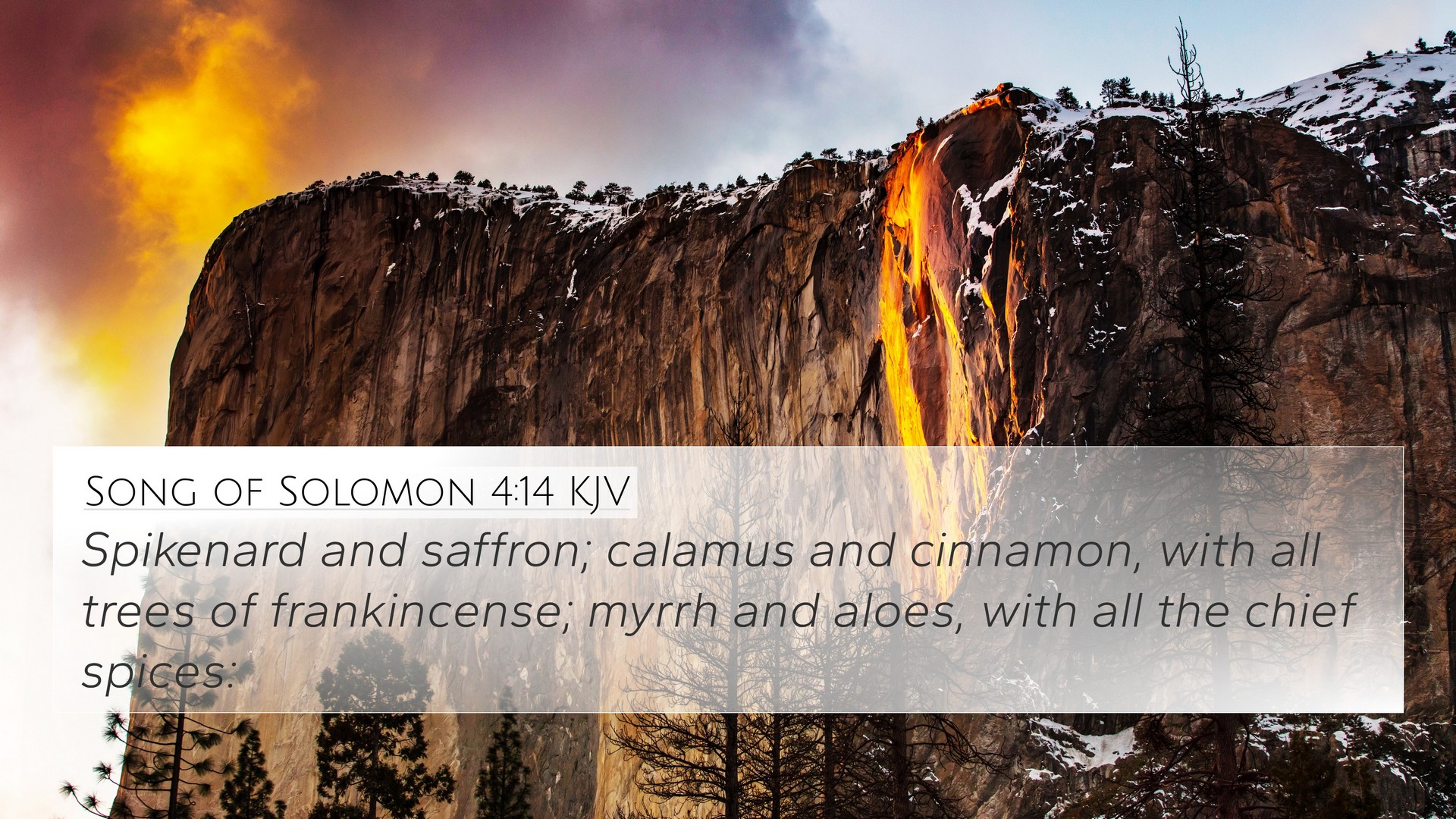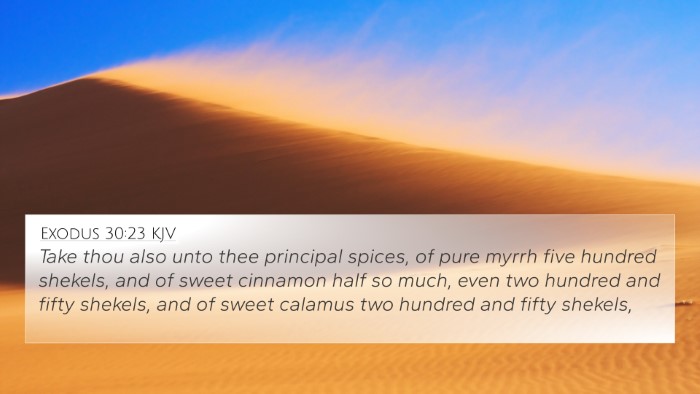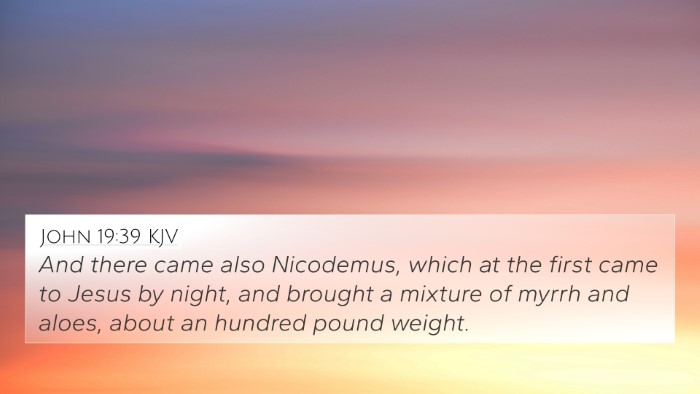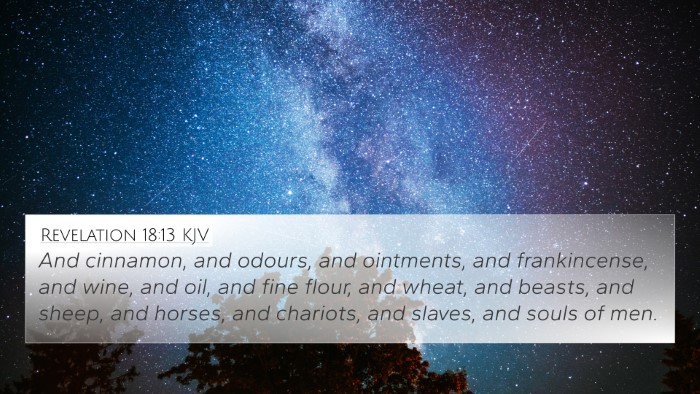Understanding Song of Solomon 4:14
Song of Solomon 4:14 is a rich and evocative verse that captures the beauty and allure of love through various natural metaphors. The verse reads:
"Spikenard and saffron; calamus and cinnamon, with all trees of frankincense; myrrh and aloes, with all the chief spices:"
This text is part of a poetic and sensual celebration of love, where the Beloved is described in terms that highlight her desirability and sweetness.
Verse Analysis
This verse employs vivid imagery to express the beloved's qualities, linking various fragrant substances to her beauty. Each element in this list can be understood in the following ways:
-
Spikenard:
This herb, known for its intoxicating fragrance, signifies devotion and purity. Historically, it was used in anointing and often associated with Christ, giving it deep spiritual significance.
-
Saffron:
Saffron, a rare and valuable spice, symbolizes richness and beauty. It illustrates the precious nature of love and illustrates the rarity of true affection.
-
Calamus:
This sweet-scented plant can represent the smoothness and pleasantness of intimate relationships, echoing the bonds formed through love.
-
Cinnamon:
Cinnamon’s warm and inviting scent reflects hospitality and can symbolize the warmth of a loving heart.
-
Frankincense:
This resin is historically linked to worship and divinity, suggesting a sacred quality to love, elevating it to a spiritual experience.
-
Myrrh:
Myrrh, often used in embalming, hints at the depth and constancy of love, even in the face of mortality, hinting at sacrificial love.
-
Aloes:
Aloes, known for their restorative properties, symbolize healing and the renewing aspects of love.
Cross-References and Thematic Connections
Song of Solomon 4:14 can be linked through various cross-references across the Bible, demonstrating the interconnectedness of scripture. Here are several verses that relate to the themes of love and beauty:
- Exodus 30:23-25: Discusses the preparation of holy anointing oil, mentioning spices reminiscent of those in Song of Solomon.
- Proverbs 27:9: Highlights the significance of a good friend’s sweet counsel compared to the fragrances mentioned, underscoring the aroma of relationships.
- Matthew 26:6-13: The anointing of Jesus by a woman with precious ointment illustrates the value of love and devotion, paralleling themes in the Song of Solomon.
- 2 Corinthians 2:15: A metaphorical connection where believers are described as a fragrance of Christ, illustrating the beauty of divine love.
- Revelation 22:2: The mention of healing leaves and fruits in the heavenly realm connects to the restorative aspects found within love.
- Song of Solomon 1:3: The fragrance of the beloved’s name, again emphasizing the aromatic metaphors linked to love.
- Philippians 4:18: Describes gifts as an aroma pleasing to God, continuing the theme of sweet scents associated with devotion and love.
- Isaiah 61:3: Refers to a "garland instead of ashes," illustrating beauty and restoration, akin to the fragrant allusions in Song of Solomon.
- Psalm 45:8: Speaks of fragrances and robes in connection with the beauty of the king and his bride, resonating with the themes of attraction and elegance.
- John 12:3: The act of anointing Jesus with fragrant oil showcases deep love and adoration, paralleling the beloved’s beauty in Song of Solomon.
Concept of Love in the Song of Solomon
The Song of Solomon, also known as the Canticles, is often understood as an allegorical work that reflects the relationship between Christ and His church. However, it also captures the beauty of human love and desire. The various spices in Song of Solomon 4:14 serve to illustrate the multifaceted nature of love:
- Physical Attraction: The verse highlights the physical allure and beauty that often accompanies love. The choice of fragrant spices symbolizes the intoxicating nature of attraction.
- Emotional Depth: Each fragrant element can also represent the emotional connections that bind lovers, akin to the sweet fragrances they share.
- Spiritual Significance: The mention of these aromatic substances can also imply a deeper, spiritual relationship, suggesting how love transcends mere physical attraction.
Conclusion
Song of Solomon 4:14 richly illustrates the beauty and complexity of love through interwoven symbolism and fragrances. This deep dive into the verse, alongside its cross-references, illuminates not just a romantic perspective but also offers profound insights into the nature of divine love, intimacy, and worship. By examining these connections, readers can uncover a deeper understanding of the Biblical text and its application to their own lives.
Further Study and Resources
To explore the themes and connections further, one can use a variety of tools for Bible cross-referencing. These include:
- Bible concordance for identifying key terms and phrases.
- Cross-reference Bible study guides to draw connections between various scripture passages.
- Online resources and study Bibles that complement traditional study methods.
- Commentaries that delve into thematic analysis and provide a historical context.
How to Utilize Cross-References Effectively
Utilizing cross-references in your study can enhance understanding and offer insights into theological principles. Here are methods to maximize their use:
- Identify the central theme of a verse and search for related scripture to deepen comprehension.
- Engage in comparative Bible verse analysis, seeking similarities and contrasts between verses.
- Use thematic Bible verse connections to create a broader understanding of certain topics.

















